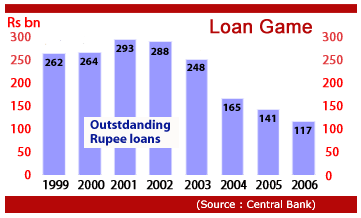The 4-year loans would pay 18.40 percent interest, 6-year loans 18.
60 percent, 7-year loans 18.70 percent and 10-year loans 19.
00 percent.
Sri Lanka had earlier announced that it was scrapping rupee loans, which are not easily tradable and was shifting to treasury bonds which can be traded in the secondary market and are issued through an auction rather than a subscription process.
The loans are issued under a 1937 law that requires re-registration to transfer, as opposed to Treasury bonds, which can sold by endorsement.
Bond Program
The bond program started in 1997, allowed the country to develop a long-term yield curve and an active government securities market backed by secondary trading.
Critics say painstaking advances made in debt markets and the monetary policy transmission mechanism through more than 10 years has been systematically rolled back in recent years.
Rising budget deficits loaded with salary and subsidy bills have forced the government to look here and there for cash and look for ways to pay lower interest especially to the 'captive' pension fund.
So far this year 57 cents of out of every tax rupee collected goes to pay state-workers salaries and pensions.
The government has been printing money to keep interest rates low since 2004, but rising inflation and depreciation of the rupee after each bout of printing has limited the volume of money that can be printed each year without de-stabilizing the economy further.
A tool of abuse
The rupee loans were discontinued partly as they were seen as tools to abuse the Employees' Provident Fund (EPF), a private sector workers' pension fund which is managed by the state.
Analysts say EPF has previously been the biggest buyer of low yielding rupee loans as private sector buyers do not want to be saddled with an illiquid instrument.

In 2006 the government retired higher yielding rupee loans and replaced them with low yield bonds by printing money to keep market interest rates low.
However market rates were allowed to rise after inflation hit 20.5 percent in January 2007.
In recent months the government has cancelled bond auction after bond auction and threatened the EPF with re-investment risk in a bid to force its managers to bid at rates below the market.
Officials revealed last week that they are forced to 'negotiate' with the government for rates, after bids are rejected at the auction.
Analysts say that while the rates announced today for the rupee loans are slightly lower than market at the shorter end, the rates are higher than market perceptions at the long-end.
A 5-year bond which has been bought heavily by foreign investors is now bid at around 17.
35 percent in the secondary market net of a 10 percent withholding tax on interest.
Net of withholding tax, dealers say the 4-year 18.40 percent rupee loan would pay 16.56 percent, the 6-year 18.60 percent bond would pay 16.74 percent, the 7-year 18.40 percent bond would pay 16.83 percent and the 10-year 19.00 percent bond would pay 17.10 percent.
The loans have a call option allowing the government to redeem them in three years, making them 3-year loans if the government manages to cut the deficit and bring down interest rates in that time.
"The government is hoping to strike oil within three years, so may be rates will come down then," a dealer said.
Sri Lanka last issued rupee loans in large volumes in 2001 when the economy contracted by 1.
5 percent, after an expanding budget deficit in the previous two years pushed bond yields above 22 percent and the rupee came under severe pressure from money printing. .
